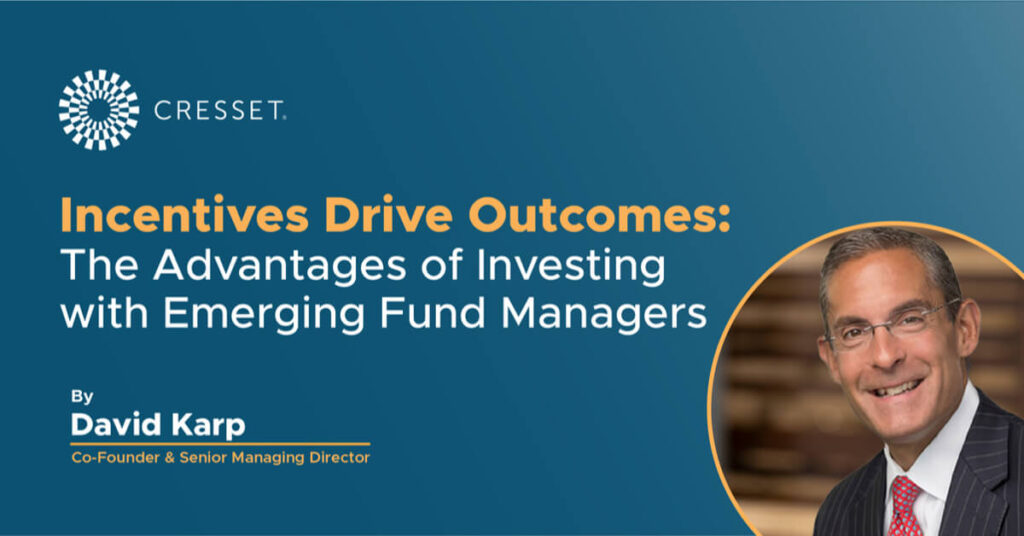
By David Karp, Co-Founder, Senior Managing Director
Bigger is better, right? Not when incentives drive outcomes.
Tiger Management, the renowned hedge fund led by Julian Robertson, achieved an impressive annual return of nearly 32% (after fees) from its inception in 1980 to its peak in 1998*. However, despite this remarkable record, Tiger’s funds ultimately incurred losses for its investors overall. This was likely due to the influx of investments into Tiger after the peak of its success, when remarkable gains were achieved on a smaller pool of assets under management (AUM).
The case of Tiger Management serves as a valuable example of the potential costs of investing with the “right” fund manager at the wrong time.
Within the wealth management industry, there is a phenomenon among many large asset managers, investment firms, and big banks that motivates them to start engaging in asset accumulation, rather than asset management. Once targeted pools of capital reach a certain size, the alignment between fund manager and investor can shift. The fund manager is often incentivized to accumulate assets and earn passive income via the management fees paid by the investor.
For a wealth advisor or advisory firm, size and scale matter. One can drive pricing, preference, terms, and garner attention, as well as results through size and scale. For an asset manager or investor, size can be a detriment. The recurring management fee becomes as important, if not more important, than a “success fee,” or “carried interest”. The business becomes not about selecting great investments, but accumulating assets. For example, an emerging manager who manages $400 million with a 2%/20% fee structure (2% management fee, 20% success fee), has significant expenses and the 2% management fee, or $8 million, is not making anyone “wealthy” when you have a seasoned and established team with an existing business infrastructure. However, for a $25 billion private equity fund run by a manager with a “2%/20%” fee structure, the incentive to perform is less critical because the 2% annual fee is a massive dependable and recurring revenue stream, making the incentive fee almost secondary.
While smaller or “emerging” fund managers are often driven to perform by incentives, they are not all equal by any means. In fact, the diligence of these managers is critical. Running an investment firm requires two key skillsets; being a prudent and successful investor, along with the ability to run and operate a business. Both are paramount for client success and no stone should be unturned when it comes to working with prominent fund managers.
Two Views of Emerging Fund Managers
A significant issue with large wealth management firms is often a reluctance to work with emerging fund managers. To be clear, “emerging” does not mean “inexperienced” or “green.” Emerging firms can boast highly skilled and successful in-house talent, often comprised of professionals from within the founders’ network. An example would be the series of successful firms that spawned out of Tiger Management, known as the “Tiger Cubs.” Many have continued to have success for their investors.
At Cresset, we are proud to be on the “call list” for many emerging fund managers. These managers are often inventive and hungry for success, and it shows in their performance. They are looking for dependable capital partners. Their time is best spent on their core competency, managing money versus marketing. Our size, scale, and client sophistication make us an attractive capital partner.
To be clear, it’s critical to have a firm like Cresset with the capabilities and scale to conduct due diligence with any fund manager, emerging managers included. That said, many big banks won’t put emerging fund managers on their platforms, as they prefer to only partner with established firms to avoid the due diligence needed to work with those managers. They also may have tens of thousands of advisors to serve, and a small fund may not want any single partner being too large of a fund’s percentage of assets, because partners may leave (for reasons other than performance), putting their business at risk. Large firms may also embrace a “pay-to-play model,” where they require a manger to share in the management fees or carried interest in order to have access to their sales force. Successful managers know once established, this need not be surrendered. (See: Fees vs Cost)
A nimble firm like Cresset has the flexibility to vet these emerging organizations and invest in distinct and compelling opportunities, serving the best interests of our clients while bringing an institutional level of diligence, as doing the “homework” may be as important as the investment acumen itself.
When evaluating investment opportunities, it is critical to remember that incentives drive outcomes. As legendary private equity leader David Rubenstein famously said, “Show me the incentives; I will tell you the outcomes.”
What are your mangers’ incentives?
* Source: Robertson to Close Tiger Funds; March 31, 2000; The Washington Post
About Cresset
Cresset is an independent, award-winning multi-family office and private investment firm with more than $235 billion in assets under management and advisement (as of 10/31/2025). Cresset serves the unique needs of entrepreneurs, CEO founders, wealth creators, executives, and partners, as well as high-net-worth and multi-generational families. Our goal is to deliver a new paradigm for wealth management, giving you time to pursue what matters to you most.
https://cressetcapital.com/disclosures/
